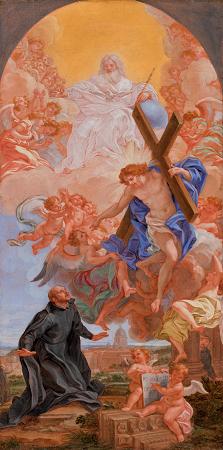Saint Ignatius of Loyola. Ignatius is remembered as a talented spiritual director. He recorded his method in a celebrated treatise called the Spiritual Exercises, a simple set of meditations, prayers, and other mental exercises, first published in 1548. Ignatius was beatified in 1609, and then canonized, receiving the title of Saint on 12 March 1622. His feast day is celebrated on 31 July. He is the patron saint of the Basque provinces of Gipuzkoa and Biscay as well as the Society of Jesus, and was declared patron saint of all spiritual retreats by Pope Pius XI in 1922. Ignatius is also a foremost patron saint of soldiers. Inigo López de Loyola was born in the municipality of Azpeitia at the castle of Loyola in today's Gipuzkoa, Basque Country, Spain. He was baptized Inigo, after St. Enecus Abbot of Oña, a Basque medieval, affectionate name meaning My little one. It is not clear when he began using the Latin name Ignatius instead of his baptismal name Inigo. Historian Gabriel María Verd says that Inigo did not intend to change his name, but rather adopted a name which he believed was a simple variant of his own, for use in France and Italy where it was better understood. Inigo was the youngest of thirteen children. His mother died soon after his birth, and he was then brought up by María de Garín, the local blacksmith's wife. Inigo adopted the surname de Loyola in reference to the Basque village of Loyola where he was born. As a boy Inigo became a page in the service of a relative, Juan Velázquez de Cuéllar, treasurer of the kingdom of Castile. As a young man Inigo had a great love for military exercises as well as a tremendous desire for fame. He framed his life around the stories of El Cid, the knights of Camelot, and the Song of Roland. He joined the army at seventeen, and according to one biographer, he strutted about with his cape slinging open to reveal his tight-fitting hose and boots; a sword and dagger at his waist. According to another he was a fancy dresser, an expert dancer, a womanizer, sensitive to insult, and a rough punkish swordsman who used his privileged status to escape prosecution for violent crimes committed with his priest brother at carnival time. Upon encountering a Moor who denied the divinity of Jesus, he challenged him to a duel to the death, and ran him through with his sword. He dueled many other men as well. In 1509, at the age of 18, Inigo took up arms for Antonio Manrique de Lara, 2nd Duke of Najera. His diplomacy and leadership qualities earned him the title servant of the court, which made him very useful to the Duke.Under the Duke's leadership, Inigo participated in many battles without injury. But at the Battle of Pamplona in 1521 he was gravely injured when a French-Navarrese expedition force stormed the fortress of Pamplona on 20 May 1521, and a cannonball ricocheting off a nearby wall shattered his right leg. Inigo was returned to his father's castle in Loyola, where, in an era that knew nothing of anesthetics, he underwent several surgical operations to repair the leg, having the bones set and then rebroken. In the end, these operations left his right leg shorter than before. Inigo would limp for the rest of his life, and his military career was over.
more...








